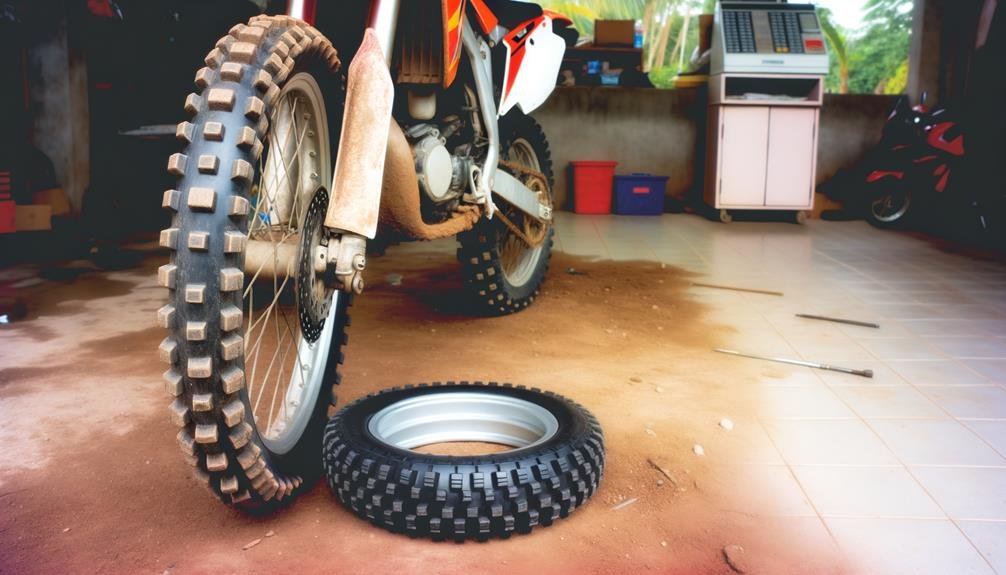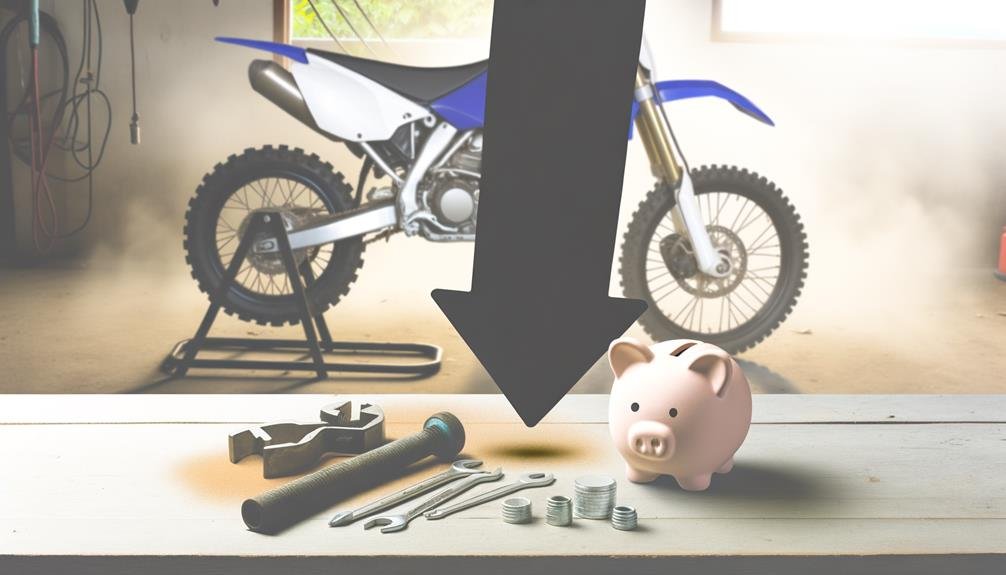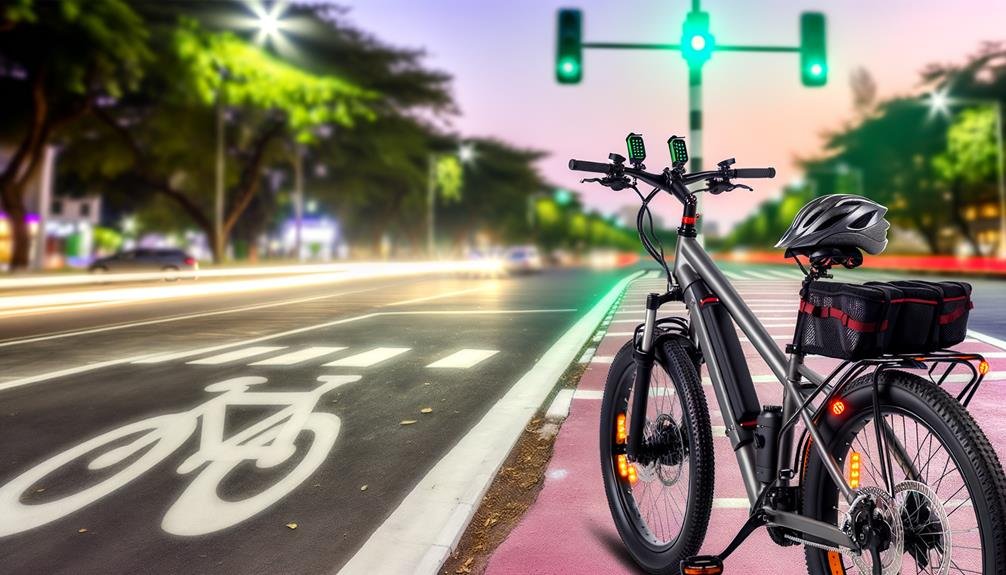Charles Miller is a veteran bike enthusiast with over 12 years of experience dealing with bikes as a mechanic. Despite immense love and expertise for...
The ongoing costs associated with maintaining a dirt bike are an often overlooked but critical aspect of ownership, and they can vary significantly based on numerous parameters.
These costs range from essential items such as tires, insurance, and riding gear, to the more routine costs like fuel, oil changes, and regular servicing. They can also extend to less frequent but considerable expenses like part replacements and professional repair services.
As an owner, it's imperative to understand, anticipate, and manage these costs effectively.
With this in mind, let's consider the primary factors that influence dirt bike maintenance costs and explore strategies for cost-effectively maintaining your bike.
- Key Takeaways
- Understanding Dirt Bike Maintenance
- Breakdown of Maintenance Costs
- Tire Replacement and Costs
- Importance of Insurance
- Riding Gear Maintenance
- Fuel Costs Explained
- Essential Tools and Equipment
- Cost of Replacement Parts
- Routine Servicing and Repairs
- Tips to Reduce Maintenance Costs
- Frequently Asked Questions
- Conclusion
Key Takeaways
- Tire maintenance is a significant factor in dirt bike maintenance costs, with replacement needed 2-3 times a year and costs ranging from $50 to $250 per tire.
- Insurance is an important expense to consider, averaging around $950 per year, providing financial protection and peace of mind for riders.
- Fuel consumption and oil changes can contribute to maintenance costs, with prices ranging from $3 to $5 per gallon of fuel and $10 to $15 per quart of oil.
- Replacement parts and professional service fees can vary greatly, with parts costing between $10 and $500 and service fees ranging from $50 to $150 per hour.
Understanding Dirt Bike Maintenance
Diving into the realm of dirt bike maintenance, it is paramount to understand the various costs involved, from tire upkeep and insurance to fuel consumption and replacement parts, each contributing significantly to the overall expenditure.
Tire maintenance, for instance, is a frequent and essential task with rear tires typically requiring replacement three times per year and front tires twice, costing between $50 and $150 per tire.
Insurance costs, often overlooked, average around $950 annually. Moreover, the maintenance cost per hour of fuel usage can range from $3 to $5, with the average dirt bike consuming a gallon per hour. The addition of synthetic oil, at $10-$15 per quart, further escalates the cost.
Replacement parts, another key aspect of dirt bike maintenance, can range from $10 for minor components like levers and grips to $500 for a Top-End Rebuild kit. Professional service fees add to the cost, with a full service typically priced between $200-$300.
Breakdown of Maintenance Costs
Delving into the specifics, the comprehensive breakdown of dirt bike maintenance costs reveals a wide array of expenses, from frequent tire replacements and insurance to the consumption of fuel and synthetic oil, along with the potential costs of replacement parts and professional service fees.
Given the technical nature of these costs, the table below provides a succinct summary:
| Maintenance Task | Frequency | Cost Range |
|---|---|---|
| Tire Replacement | 2-3 times/year | $50 – $250 per tire |
| Insurance | Annually | $950 |
| Fuel and Oil | Variable | $3 – $5 per gallon, $10 – $15 per quart of oil |
| Replacement Parts and Service Fees | As required | $10 – $500 for parts, $50 – $150 per hour for service |
The Cost to Maintain a dirt bike is not small, with an average yearly maintenance cost around $856. Additional costs, like rear tire replacement every 100 hours, top-end kit replacement, and air filter replacement, increase the breakdown of maintenance costs to roughly $650 per 100 hours. The crux of the matter is that regular and diligent maintenance is vital for optimal performance and longevity of your dirt bike.
Tire Replacement and Costs

Tire replacement constitutes a significant portion of dirt bike maintenance costs. The frequency and cost of replacement are contingent on the type of tire and riding conditions. Typically, rear tires require changing thrice annually, and front tires twice. The costs per tire can range from $50 for off-road tires to $250 for dual-sport tires.
In addition to the cost of the tires themselves, there are additional services that can add to the overall expense. These services include tire change, tube replacement, and balancing. It is important to understand the lifespan of the tires and accurately estimate replacement costs to properly budget for these expenses.
Understanding Tire Lifespan
In order to ensure safety and optimal performance of a dirt bike, it's crucial to understand the lifespan of its tires, the frequency of their replacement, and the costs associated with these services. Rear tires typically need changing three times per year, while the front tires are replaced twice. The lifespan of a dirt bike tire is around 20-30 hours of ride time.
Here's a brief cost overview:
| Service | Cost Range |
|---|---|
| Off-road tires | $50-$150 |
| Motocross tires | $80-$200 |
| Dual-sport tires | $100-$250 |
| Tire change or tube replacement | $30-$99 |
| Average tire lifespan | 20-30 hours of ride time |
Knowing these costs helps to Maintain A Dirt bike effectively, ensuring optimal safety and performance.
Estimating Replacement Expenses
Assessing the overall replacement expenses for dirt bike tires involves not only the cost of the tires themselves but also the professional services required for tire change or tube replacement.
A rear tire, usually changed three times a year, can cost between $50 and $250 depending on the type. Including professional services, you could spend up to $300 per rear tire replacement.
Additionally, maintenance costs like spark plugs, brakes, chain and sprockets, and crucial top end rebuilds can push annual costs to $1000 or more. A top end rebuild, necessary for optimal performance, could set you back $725 plus parts for a 4-stroke engine.
Therefore, careful cost estimation is key to maintaining your dirt bike without breaking the bank.
Importance of Insurance
Understanding the importance of insurance for your dirt bike is paramount, as it offers essential protection for yourself and others in the event of accidents or damage. This is especially significant for those who are investing in their first dirt bike. Insurance not only protects your investment but also safeguards against potential liabilities.
- Financial Protection: Insurance can cover the cost of damages or injuries caused by accidents, which can amount to a substantial financial burden without coverage. Average insurance costs can be around $950 per year, a figure that underscores 'How Much Does It Cost' to maintain a dirt bike responsibly.
- Legal Compliance: Depending on your location, having insurance may be legally required. Non-compliance can result in fines or penalties, adding unnecessary expenses and complications.
- Peace of Mind: Knowing that you are insured provides peace of mind, allowing you to focus on refining your skills and enjoying the ride.
Neglecting insurance could lead to significant financial consequences in the event of an accident. Therefore, incorporating insurance into your initial budget when buying your first dirt bike is a wise and responsible decision.
Riding Gear Maintenance

While insurance is a key aspect of financial protection for dirt bike enthusiasts, an equally vital component for safeguarding oneself involves the regular maintenance and periodic replacement of riding gear. Helmets, boots, and chest protectors require regular inspection for wear and tear. Cleaning and ensuring fit and functionality are fundamental aspects of riding gear maintenance.
Damage to gear after falls or accidents is inevitable and must be promptly addressed. The cost of maintaining and replacing riding gear can vary significantly:
| Gear | Cost Range |
|---|---|
| Helmets | $100 – $600 |
| Boots | $150 – $600 |
| Chest Protectors | $300 – $600 |
These figures reflect the financial investment necessary to ensure optimal performance and safety on the dirt bike. It is important to remember that the cost of not maintaining your riding gear can far exceed these amounts, in terms of both financial and health risks. An effective maintenance schedule is essential for the longevity of your gear and your safety. In conclusion, regular maintenance of riding gear is crucial to the overall experience and safety of dirt bike riding.
Fuel Costs Explained
In the realm of dirt bike maintenance, fuel costs represent a significant ongoing expense. To effectively manage these costs, it is crucial to understand the factors influencing fuel consumption and consider methods for optimizing fuel efficiency.
This discussion will focus on the average fuel consumption rates of dirt bikes and practical strategies to enhance fuel economy.
Understanding Fuel Consumption
Gauging the fuel consumption of a dirt bike is pivotal in comprehending the overall maintenance costs. The average dirt bike consumes approximately one gallon of fuel per hour of riding, at a cost range of $3 to $5 per gallon.
- Annual Fuel Costs: For active riders, riding 200 hours per year, the fuel cost can be between $600 to $1000 per year.
- Fuel Type: Premium unleaded gasoline is recommended for most dirt bikes. This higher grade fuel, while more expensive, ensures optimal performance and longevity of the engine.
- Fuel Efficiency: Factors affecting fuel consumption include riding style, terrain, and the bike's condition. Regular maintenance can improve fuel efficiency, ultimately reducing costs.
Understanding fuel consumption and its impact on total maintenance costs can help dirt bike enthusiasts budget effectively.
Optimizing Fuel Efficiency
Optimizing fuel efficiency is a practical approach to managing the ongoing costs associated with maintaining a dirt bike. This can be done by considering the average fuel consumption rates, the price of premium unleaded gasoline, and the potential impact of regular maintenance on fuel economy.
Regular service, including diligent oil changes at prescribed intervals, can bolster fuel efficiency and help to stretch each gallon further. Utilizing synthetic oil, typically costing $10-$15 per quart, can enhance engine performance and efficiency.
Tire changes, necessary every 20-30 hours of riding, can also affect fuel consumption. Therefore, mindful maintenance and riding practices can alleviate some costs per ride hour.
Essential Tools and Equipment

Maintaining a dirt bike's optimal performance requires a selection of essential tools and equipment. This ensemble of tools is the backbone of your maintenance routine, allowing you to perform necessary tasks effectively and efficiently.
The first item you will need is a high-quality tool kit. A comprehensive tool kit provides everything you need, including wrenches, sockets, and screwdrivers, for general maintenance and repairs.
Secondly, tire maintenance tools are crucial. These include a tire changing kit, a quality air compressor for inflating tires, and a tire pressure gauge.
Lastly, a motorcycle stand or lift is necessary for elevating the bike during maintenance tasks. Additionally, a chain breaker and riveting tool are essential for chain maintenance.
Incorporating these essential tools and equipment into your routine ensures your dirt bike remains in peak condition. Remember, investing in the right tools is not just about saving on maintenance costs but also about ensuring your ride is safe and enjoyable.
Cost of Replacement Parts
The financial aspect of maintaining a dirt bike extends beyond initial purchase and routine upkeep. Various components, from essential parts like levers and grips to more costly items such as engine rebuild kits, can impact the overall maintenance budget significantly.
Understanding the average costs of these parts and strategies to maximize their lifespan can lead to substantial savings over time.
Essential Dirt Bike Parts
Investing in essential replacement parts for your dirt bike is a crucial aspect of maintenance, with costs varying significantly depending on the type and frequency of replacements needed.
- Air Filter: This essential dirt bike part needs regular replacement to ensure optimal performance. Prices vary, but a high-quality air filter typically costs between $10 and $50.
- Chain and Sprockets: These critical components need periodic replacement to maintain the dirt bike's drive system. A set usually costs between $100 and $200.
- Tires: Regular tire replacement is crucial for safety and performance. Off-road tires typically range from $50 to $150, motocross tires from $80 to $200, and dual-sport tires between $100 and $250.
Maintaining these essential parts will ensure your dirt bike performs at its best and lasts longer.
Average Part Replacement Costs
How much, then, might one expect to spend on average for the replacement of various parts on a dirt bike? A detailed understanding of average part replacement costs is essential to effectively maintain a dirt bike.
For common parts like levers, grips, and footpegs, expect to spend $10 to $50 per piece.
A top end engine rebuild kit may range from $200 to $500, while suspension components can cost between $100 to $500 per part.
Tire services, such as tire change or tube replacement, can cost around $30 off bike and $50 on bike per tire.
These costs can fluctuate based on the bike's condition and specific needs, so regular maintenance is crucial to minimize unexpected expenses.
Maximizing Parts Lifespan
Interested in prolonging the lifespan of your dirt bike parts to reduce frequent replacements and save on costs? Proper maintenance routines and adherence to manufacturer-recommended schedules can significantly aid in achieving this goal.
To maximize parts lifespan, ensure you:
- Regularly inspect and maintain critical components like the clutch, water pump, and radiator. This preventive measure can halt premature wear.
- Pay attention to the often overlooked parts such as levers, grips, and footpegs. Their longevity can be extended with proper care.
- Stick to the manufacturer's suggested maintenance schedule, particularly for engine and transmission services.
Routine Servicing and Repairs
Regularly maintaining and repairing a dirt bike is crucial for its optimal performance, encompassing aspects such as tire upkeep, replacement of parts, fuel consumption, and the acquisition of appropriate riding gear. Tire maintenance can cost between $50 to $250 per tire, with an average lifespan of about 20-30 hours of riding. Fuel consumption is another regular expense, with the average dirt bike consuming one gallon per hour of riding.
For routine servicing and repairs, common parts like levers, grips, and footpegs can range from $10 to $500, with professional service fees ranging from $50 to $150 per hour. The costs of front and rear brake pads, sprockets, and lights are also part of the maintenance budget.
The table below provides an overview of the average costs for essential maintenance and repair items:
| Item | Average Cost | Lifespan/Usage |
|---|---|---|
| Tire | $50-$250 | 20-30 hours |
| Fuel | $3-$5/gallon | 1 gallon/hour |
| Maintenance | $9.10/hour | per riding hour |
| Parts (Levers, Grips, Footpegs) | $10-$500 | Varies |
| Service Fees | $50-$150/hour | As needed |
Tips to Reduce Maintenance Costs

Understanding and implementing a variety of strategies can significantly reduce the overall maintenance costs associated with owning a dirt bike. This sport, while thrilling, can be expensive. However, by following some tips to reduce maintenance costs, you can make it much cheaper.
- Regular Maintenance: Perform regular tasks such as changing engine oil, cleaning air filters, and maintaining chain tension. Regular maintenance is a preventative measure, helping you avoid expensive repairs later.
- Proactive Inspections: Stay proactive with your dirt bike. Regularly inspect it and address any issues promptly. It's much cheaper to fix minor problems before they turn into major issues.
- DIY Maintenance: Consider doing maintenance tasks yourself. Tasks like valve adjustments or top end rebuilds can be learned and performed without professional help. This can save you money on servicing fees.
Frequently Asked Questions
Is Owning a Dirt Bike Expensive?
Owning a dirt bike can be costly, considering bike financing options, insurance considerations, and resale value. Expenses extend beyond the initial purchase, encompassing regular maintenance, insurance premiums, and potential depreciation in resale value.
Are Dirt Bikes a Lot of Maintenance?
Dirt bikes, indeed, require consistent maintenance. Tasks like routine cleaning, mechanical upkeep, and frequent tires replacement are crucial to ensure optimal performance. These maintenance activities, however, contribute to a rewarding and immersive dirt biking experience.
Is 100 Hours a Lot for a Dirt Bike?
In terms of engine longevity, 100 hours of use is not significantly high for a well-maintained dirt bike. However, usage impact can vary, and bikes may require different maintenance based on their hourly rates of usage.
Are Dirt Bikes Money Pits?
Dirt bikes can be seen as money pits due to their maintenance costs. Factors like the bike's lifespan, initial investment, and fuel efficiency play significant roles in the total cost, influencing the perception of expense.
Conclusion
In conclusion, owning and maintaining a dirt bike involves various recurring expenditures. From tire replacements to insurance, riding gear, and routine servicing, the costs can accumulate.
However, with proper management and regular upkeep, these expenses can be controlled effectively. Thus, understanding the intricacies of dirt bike maintenance is crucial for any rider, ensuring the longevity of the bike and guaranteeing a safe and enjoyable riding experience.

Charles Miller is a veteran bike enthusiast with over 12 years of experience dealing with bikes as a mechanic. Despite immense love and expertise for his Tacoma, he rides his Trek Ebike more. Anytime you meet him, you’ll either hear him talking about Bikes, or writing about all things bikes and cars on this blog.
More Posts


